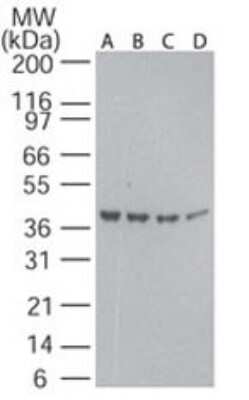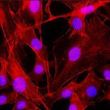beta Actin (ACTB) Rabbit Polyclonal Antibody
Frequently bought together (3)
Transient overexpression lysate of actin, beta (ACTB)
USD 396.00
Other products for "beta Actin"
Specifications
| Product Data | |
| Applications | IHC, WB |
| Recommended Dilution | Immunocytochemistry/ Immunofluorescence: 1:100, Simple Western: 1:12.5, Western Blot: 0.25-1 ug/ml, Immunohistochemistry-Paraffin: 10 ug/mL, Immunohistochemistry, Knockdown Validated |
| Reactivities | Human, Mouse, Rat |
| Host | Rabbit |
| Clonality | Polyclonal |
| Immunogen | Amino acids 2-16 (CDDDIAALVIDNGSG) of actin protein were used as the immunogen. |
| Formulation | PBS containing 0.05% BSA, 0.05% Sodium Azide. Store at 4C short term. Aliquot and store at -20C long term. Avoid freeze-thaw cycles. |
| Concentration | lot specific |
| Purification | Protein G purified |
| Conjugation | Unconjugated |
| Storage | Store at -20°C as received. |
| Stability | Stable for 12 months from date of receipt. |
| Gene Name | actin, beta |
| Database Link | |
| Background | Actin is a globular protein found in all eukaryotic cells (the only known exception being nematode sperm) where it may be present at concentrations of over 100 uM. It is the monomeric subunit of two types of filaments: microfilaments, one of the three major components of the cytoskeleton, and thin filaments, part of the contractile apparatus in muscle cells. Actin participates in many important cellular processes including muscle contraction, cell signaling, motility and division, cytokinesis, vesicle and organelle movement, and the establishment and maintenance of cell junctions and shape. In vertebrates, three main groups of actin isoforms, alpha, beta, and gamma have been identified. The alpha actins are found in muscle tissues and are a major constituent of the contractile apparatus. The beta and gamma actins co-exist in most cells as components of the cytoskeleton, and as mediators of internal cell motility (Doherty GJ, et al 2008). Among these actins, beta actin, which is expressed constantly, and at high levels, in all the tissue types used in protein research except muscle (skeletal and cardiac). Beta actin acts as a useful loading control in Western blot analysis. Loading controls serve a number of purposes; they ensure the protein of interest has been correctly loaded on the gel, that it is being transferred correctly, and that all reagents are functioning normally. Loading controls can also be used to compare amounts of protein tested (or loaded) per gel lane in western blotting. While very useful when comparing lysates of the same origin (for example transfected and untransfected HEK 293s), comparing lysates from different tissues can be complex. Actin is almost universally expressed, but different tissues express different amounts. In western blotting, an actin antibody titered to the detection limit can show these differences, while an actin antibody used well above the detection limit can show a response that appears equally robust in all samples probed. Therefore caution must be used when using actin or another 'loading control antibody.' |
| Synonyms | BRWS1; PS1TP5BP1 |
| Note | This antibody is not suitable for testing heart or muscle lysate loading. |
| Reference Data | |
| Protein Families | ES Cell Differentiation/IPS |
| Protein Pathways | Adherens junction, Arrhythmogenic right ventricular cardiomyopathy (ARVC), Dilated cardiomyopathy, Focal adhesion, Hypertrophic cardiomyopathy (HCM), Leukocyte transendothelial migration, Pathogenic Escherichia coli infection, Regulation of actin cytoskeleton, Tight junction, Vibrio cholerae infection, Viral myocarditis |
Documents
| Product Manuals |
| FAQs |
| SDS |
{0} Product Review(s)
0 Product Review(s)
Submit review
Be the first one to submit a review
Product Citations
*Delivery time may vary from web posted schedule. Occasional delays may occur due to unforeseen
complexities in the preparation of your product. International customers may expect an additional 1-2 weeks
in shipping.






























































































































































































































































 Germany
Germany
 Japan
Japan
 United Kingdom
United Kingdom
 China
China







